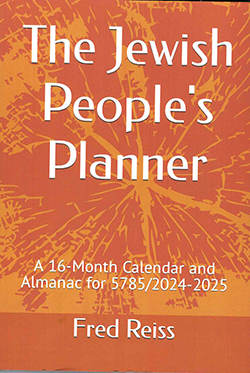The Jewish People’s Planner: A 16-Month Calendar and Almanac for 5785/ 2024-2025 by Fred Reiss © 2024; $8.75 on Amazon.

 SAN DIEGO –Author Fred Reiss, who has his doctorate in education, occasionally contributes book reviews to San Diego Jewish World, typically on religious subjects. His real love, however, is the intricate way by which people keep track of the passage of time – the calendar! – and how different systems like the Gregorian calendar and the Hebrew calendar interact in the lives of observant American Jews.
SAN DIEGO –Author Fred Reiss, who has his doctorate in education, occasionally contributes book reviews to San Diego Jewish World, typically on religious subjects. His real love, however, is the intricate way by which people keep track of the passage of time – the calendar! – and how different systems like the Gregorian calendar and the Hebrew calendar interact in the lives of observant American Jews.
So, he has put together a joint Hebrew and Gregorian calendar and planner, in which Jewish and American holidays are listed on a day-by-day basis along with listings of candle lighting times for the start of Shabbats and Jewish holidays as well as what Torah portions will be read in synagogues around the world on each Saturday. The candle-listing time is geared to New York City, but there is a conversion chart for 16 other cities across the United States, including San Diego.
Each week receives a two-page spread in his planner, with Sunday at the top of the left page and Saturday next to the bottom. At the very bottom of the left-hand page is an inspirational quotation, drawn from a surprising variety of sources. Flipping pages at random, I found “There is nothing impossible to they who will try” attributed to Alexander the Great and “If your ship doesn’t come in, swim out to it” attributed to Jonathan Winters.
The right-hand page contains a box for people to list their goals and objectives for that week as well as their notes and reflections. There are before- and after-calendars for the current month, and a space to list nine things to do for that week.
The double-page entries begin on September 1, 2024, and end Jan. 3, 2026.
Then come calendars recapping all the holidays and special observances in each of the 16 months covered by the planner. Next are explanations of Jewish holidays, both the major ones and the minor ones. Also listed are anticipated astronomical events in each month.
Next in order are a glossary explaining some Jewish symbols and their meanings; a listing of still standing old synagogues across the United States; countries with the largest Jewish populations (Israel, U.S., France, Canada, United Kingdom, Argentina, Russia, Germany, Australia, and Brazil) and 21 countries in alphabetical order, from Armenia to Taiwan, with population counts of fewer than 100 Jews. It also lists metropolitan areas with the largest Jewish populations, with the first being Tel Aviv with 3,891,800 followed by New York with 2,109,300.
Charts looking ahead to the holidays that will occur in 2026 follow, and the book concludes with a chart showing federal, religious and national-Israel holidays in 2027.
*
Donald H. Harrison is publisher and editor of San Diego Jewish World.